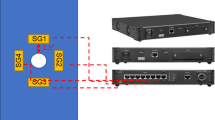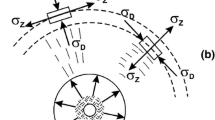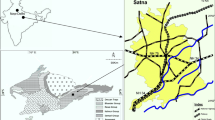Abstract
Drilling and blasting play an important role in operation cycle of a mine or quarry. Optimum blast design plays a pivotal role to achieve maximum utilization of explosive energy and blast fragmentation. Only 20 to 30% of explosive energy is utilized for fracturing and fragmentation of rock, and the rest of the energy is converted in noise, air overpressure, ground vibration, etc. It has been observed that using the low-density explosive may reduce the deleterious effect of engineering blasting with desired blast fragmentation. This paper substantiates this fact wherein distinct explosive energy utilization enhancement has been achieved with the use of low-density explosive and reduces ground vibration. This paper outlines the on-field assessment of low-density explosive in Quarry AB of Tata Steel West Bokaro Division. It is a solid sensitized emulsion blend. It comprises products designed for blasting in dry, dewatered, and wet blast-hole applications. Low-density explosive provides the capability to better match explosive performance to ground conditions. Being a low-density, low-energy explosives, it provides an added benefit of reducing the environmental effects of blasting. The key objective of the field assessment was to test the on-field performance of the new low-density bulk products and its effects on blast-induced ground vibration and air overpressure.







Similar content being viewed by others
References
Agrawal H, Mishra AK (2018a) Probabilistic analysis on scattering effect of initiation systems and concept of modified charge per delay for prediction of blast induced ground vibrations. Measurement 130:306–317
Agrawal H, Mishra AK (2018b) Evaluation of initiating system by measurement of seismic energy dissipation in surface blasting. Arab J Geosci 11:345. https://doi.org/10.1007/s12517-018-3683-3
Agrawal H, Mishra AK (2018c) Modified scaled distance regression analysis approach for prediction of blast-induced ground vibration in multi-hole blasting. J Rock Mech Geotech Eng
Agrawal H, Mishra AK (2018d) A study on influence of density and viscosity of emulsion explosive on its detonation velocity. Model Meas Control C 78:316–336
Agrawal H, Mishra AK (2019) An innovative technique of simplified signature hole analysis for prediction of blast-induced ground vibration of multi-hole/production blast: an empirical analysis. Nat Hazards:1–22. https://doi.org/10.1007/s11069-019-03801-2
Armaghani DJ, Hajihassani M, Mohamad ET, Marto A, Noorani SA (2014) Blasting-induced flyrock and ground vibration prediction through an expert artificial neural network based on particle swarm optimization. Arab J Geosci 7:5383–5396. https://doi.org/10.1007/s12517-013-1174-0
Arthur CK, Temeng VA, Ziggah YY (2019) Multivariate adaptive regression splines (MARS) approach to blast-induced ground vibration prediction. Int J Min Reclam Environ 00:1–25. https://doi.org/10.1080/17480930.2019.1577940
Bakhshandeh Amnieh H, Bahadori M (2014) Safe vibrations of spilling basin explosions at “Gotvand Olya Dam” Using artificial neural network. Arch Min Sci 59:1087–1096. https://doi.org/10.2478/amsc-2014-0075
Brent GF, Armstrong LW (1998) Large diameter presplitting improved through two novel techniques. In: Proceedings ISEE Annual Conference 1998, pp 511–520
Chiappetta RF (1998) Blast monitoring instruments and analysis techniques, with an emphasis on field application, FRAGBLAST. Int J Blasting Fragm 1:79–96
Cooper PW (1996) Acceleration, formation, and flight of fragments. Explos Eng Wiley-VCH:385–394
Dong L, Li X, Xu M, Li Q (2011) Comparisons of random forest and Support Vector Machine for predicting blasting vibration characteristic parameters. Procedia Eng 26:1772–1781. https://doi.org/10.1016/j.proeng.2011.11.2366
Hamdi E, Bouden Romdhane N, du Mouza J, Cleac’h JM (2008) Fragmentation energy in rock blasting. Geotech Geol Eng 26:133–146. https://doi.org/10.1007/s10706-007-9153-4
Heit A (2011) An investigation into the parameters that affect the swell factor used in volume and design calculations at Callide open cut coal mine
Hunter C, Fedak K, Todoeschuck J (1993) Development of low density explosives with wall control applications. In: Proceedings of the Annual Conference on Explosives and Blasting Technique. INTERNATIONAL SOCIETY OF Explosives Engineers, p 549
Jackson M (1993) Low strength water gel explosive. In: Proceedings of the Annual Conference on Explosives and Blasting Technique. International Society of Explosives Engineers, p 493
Kumar S, Ranjan P, Mishra AK, et al (2017) Implementation of FlexigelTM bulk system–a case study of West Bokaro Colliery, Tata Steel Limited. In: 7th Asian mining Congresss
Lownds CM, Wallace BW (1986). The peformance testing of permitted explosives for coal mines. Journal of the Southern African Institute of Mining and Metallurgy, 86(10):415–423
Lownds CM (1991) Energy partition in blasting. In: Third Annual High-Tech Seminar: State of the Art Blasting Technology, Instrumentation and Explosives Applications. Blasting Analysis International (BAI)
Mishra AK (2003) Environmental impacts of blasting and mitigating measures-experience in Indian surface coal mines. ERZMETALL 56:724–730
Mishra AK (2013) Unlocking possibility of blasting near residential structure using electronic detonators. J Geol Soc India 81:429–435. https://doi.org/10.1007/s12594-013-0054-2
Mishra AK, Agrawal H, Raut M (2019) Effect of aluminum content on detonation velocity and density of emulsion explosives. J Mol Model 25:70–79
Miyake A, Takahara K, Ogawa T, Ogata Y, Wada Y, Arai H (2001) Influence of physical properties of ammonium nitrate on the detonation behaviour of ANFO. J Loss Prev Process Ind 14:533–538
Monjezi M, Hasanipanah M, Khandelwal M (2013) Evaluation and prediction of blast-induced ground vibration at Shur River Dam, Iran, by artificial neural network. Neural Comput Applic 22:1637–1643
Rao YS (2012) Prediction of ground vibrations in opencast mine using nonlinear regression analysis. Int J Eng Sci Technol 4
Rock J (2004) Improving blasting outcomes using softload low density explosives. In: Proceedings Explo
Rock J, Maurer A, Pereira N (2005) Coming of age for low-density explosives
Rowe JL, Goodridge R, Stow D, Molloy KJ (2002) Variable energy explosives for soft ground blasting. Fragblast 6:263–270
Sanchidrian JA, Segarra P, Lopez LM (2007) Energy components in rock blasting. Int J Rock Mech Min Sci 44:130–147. https://doi.org/10.1016/j.ijrmms.2006.05.002
Sayadi A, Monjezi M, Talebi N, Khandelwal M (2013) A comparative study on the application of various artificial neural networks to simultaneous prediction of rock fragmentation and backbreak. J Rock Mech Geotech Eng 5:318–324. https://doi.org/10.1016/j.jrmge.2013.05.007
Sazid M, Singh TN (2015) Numerical assessment of spacing-burden ratio to effective utilization of explosive energy. Int J Min Sci Technol 25:291–297. https://doi.org/10.1016/j.ijmst.2015.02.019
Sazid M, Saharan MR, Singh TN (2011) Effective explosive energy utilization for engineering blasting–initial results of an inventive stemming plug, SPARSH. In: 12th ISRM Congress. International Society for Rock Mechanics
Trivedi R, Singh TN, Mudgal K, Gupta N (2014) Application of artificial neural network for performance evaluation of vertical axis wind turbine rotor. Int J Ambient Energy 3:564–574. https://doi.org/10.1080/01430750.2014.915889
Wilson JM, Moxon NT (1989) The Development of a low shock energy ammonium nitrate based explosive. In: Proceedings ISEE Annual Conference 1989, pp 297–308
Xiong D, Qin H, Ren X, Wang X (2004) Use of bulk emulsion explosive to improve blasting and production performances at Jinduicheng open pit. Min Metall 4
Yunoshev AS, Plastinin AV, Sil’vestrov VV (2012) Effect of the density of an emulsion explosive on the reaction zone width. Combust Explos Shock Waves 48:319–327
Zlobin BS, Kiselev VV, Shterzer AA, Plastinin AV (2018) Use of emulsion explosives in experimental studies of flows in the bonding zone in explosive welding. Combust Explos Shock Waves 54:231–237
Acknowledgments
The authors would like to express gratitude to the mine management of M/s Tata Steel limited for extending the help for conduct trail blast of variable density explosive blast and M/s Indian Explosives Limited (a subsidiary of Orica Limited) for providing me necessary explosive and blast accessories.
Author information
Authors and Affiliations
Corresponding author
Additional information
Responsible Editor: Petr Konicek
Rights and permissions
About this article
Cite this article
Kumar, S., Mishra, A.K. Reduction of blast-induced ground vibration and utilization of explosive energy using low-density explosives for environmentally sensitive areas. Arab J Geosci 13, 655 (2020). https://doi.org/10.1007/s12517-020-05645-8
Received:
Accepted:
Published:
DOI: https://doi.org/10.1007/s12517-020-05645-8




